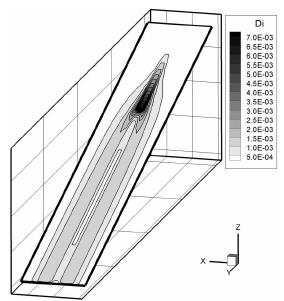- Home >> News >> Research Progress
Research Progress
Two-Dimensional Hillslope Scale Soil Erosion Model
Date:2009-07-31Source:
On a hillslope, overland flow first generates sheet erosion and then, with increasing flux, it causes rill erosion. Sheet erosion (interrill erosion) and rill erosion are commonly observed to coexist on hillslopes. Great differences exist between both the intensities and incidences of rill and interrill erosion. In this paper, a two-dimensional rill and interrill erosion model is developed to simulate the details of the soil erosion process on hillslopes. The hillslope is treated as a combination of a two-dimensional interrill area and a one-dimensional rill. The rill process, the interrill process, and the joint occurrence of rill and interrill areas are modeled, respectively. Thus, the process of sheet flow replenishing rill flow with water and sediment can be simulated in detail, which may possibly render more truthful results for rill erosion. The model was verified with two sets of data and the results seem good. Using this model, the characteristics of soil erosion on hillslopes are investigated. Study results indicate that (1) the proposed model is capable of describing the complex process of interrill and rill erosion on hillslopes; (2) the spatial distribution of erosion is simulated on a simplified two-dimensional hillslope, which shows that the distribution of interrill erosion may contribute to rill development; and (3) the quantity of soil eroded increases rapidly with the slope gradient, then declines, and a critical slope gradient exists, which is about 15-20 degrees for the accumulated erosion amount.
This paper was published as:
An Y, Liu QQ. Two-Dimensional Hillslope Scale Soil Erosion Model. Journal of Hydrologic Engineering,14(7):690-697(2009)

This paper was published as:
An Y, Liu QQ. Two-Dimensional Hillslope Scale Soil Erosion Model. Journal of Hydrologic Engineering,14(7):690-697(2009)
